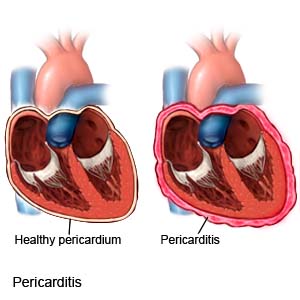Acute Pericarditis
Medically reviewed by Drugs.com. Last updated on Aug 4, 2025.
Acute pericarditis is inflammation of the pericardium. The pericardium is the thin sac that surrounds your heart. A small amount of clear fluid between the heart and the sac allows the heart to beat easily. With acute pericarditis, the amount of fluid increases and may contain pus. This can lead to problems with the way that your heart beats.
 |
WHILE YOU ARE HERE:
Informed consent
is a legal document that explains the tests, treatments, or procedures that you may need. Informed consent means you understand what will be done and can make decisions about what you want. You give your permission when you sign the consent form. You can have someone sign this form for you if you are not able to sign it. You have the right to understand your medical care in words you know. Before you sign the consent form, understand the risks and benefits of what will be done. Make sure all your questions are answered.
Activity:
You may need to rest and avoid physical activity. Ask your healthcare provider what you are allowed to do while you are in the hospital.
Medicines:
- NSAIDs help decrease swelling and pain or fever. This medicine is available with or without a doctor's order. NSAIDs can cause stomach bleeding or kidney problems in certain people. If you take blood thinner medicine, always ask your healthcare provider if NSAIDs are safe for you. Always read the medicine label and follow directions.
- Antibiotics help prevent or treat a bacterial infection.
- Steroid medicine helps lower inflammation.
Related medications
Treatment options
The following list of medications are related to or used in the treatment of this condition.
Tests:
- Blood tests are used to give healthcare providers information about how your body is working.
- Telemetry is continuous monitoring of your heart rhythm. Sticky pads placed on your skin connect to an EKG machine that records your heart rhythm.
- X-ray pictures of your lungs and heart may be used to check the fluid around your heart. Chest x-rays may show signs of infection around your heart.
- An echocardiogram is a type of ultrasound. Sound waves are used to show the structure and function of your heart.
- Transesophageal echocardiogram (TEE) is a type of ultrasound that shows pictures of the size and shape of your heart. It also looks at how your heart moves when it is beating. You may also need a TEE to check for certain problems such as blood clots or infection inside the heart.
- CT scan or MRI pictures may be used to check the amount of fluid around your heart. You may be given contrast liquid before the pictures are taken. Tell the healthcare provider if you have ever had an allergic reaction to contrast liquid. Do not enter the MRI room with any metal objects. Metal can cause serious injury. Tell the provider if you have any metal in or on your body.
- Pericardiocentesis is a procedure used to drain extra fluid from the sac. The fluid is sent to a lab to be checked for infection.
- Pericardial biopsy is a procedure used to remove a small piece of the heart sac. The piece is sent to a lab for tests.
Pericardiocentesis
may be used to drain extra fluid from the sac around your heart. If you often have symptoms of pericarditis, you may need to have balloon pericardiotomy or pericardiectomy. Ask your healthcare provider for more information about these procedures.
RISKS:
You may develop an infection or bleeding when fluid in the sac is removed. Without treatment, your heart can scar. Your heart may not beat correctly, and there might not be enough blood and oxygen getting to your body organs. This may damage your organs and be life-threatening.
CARE AGREEMENT:
You have the right to help plan your care. Learn about your health condition and how it may be treated. Discuss treatment options with your healthcare providers to decide what care you want to receive. You always have the right to refuse treatment.© Copyright Merative 2025 Information is for End User's use only and may not be sold, redistributed or otherwise used for commercial purposes.
The above information is an educational aid only. It is not intended as medical advice for individual conditions or treatments. Talk to your doctor, nurse or pharmacist before following any medical regimen to see if it is safe and effective for you.
Learn more about Acute Pericarditis
Treatment options
Care guides
Symptoms and treatments
Further information
Always consult your healthcare provider to ensure the information displayed on this page applies to your personal circumstances.
